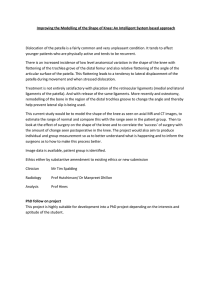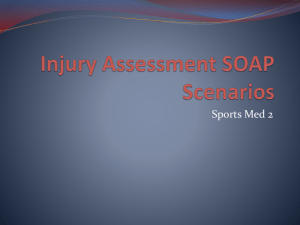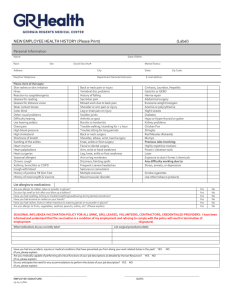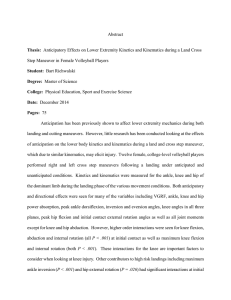Musculoskeletal Assessment
advertisement
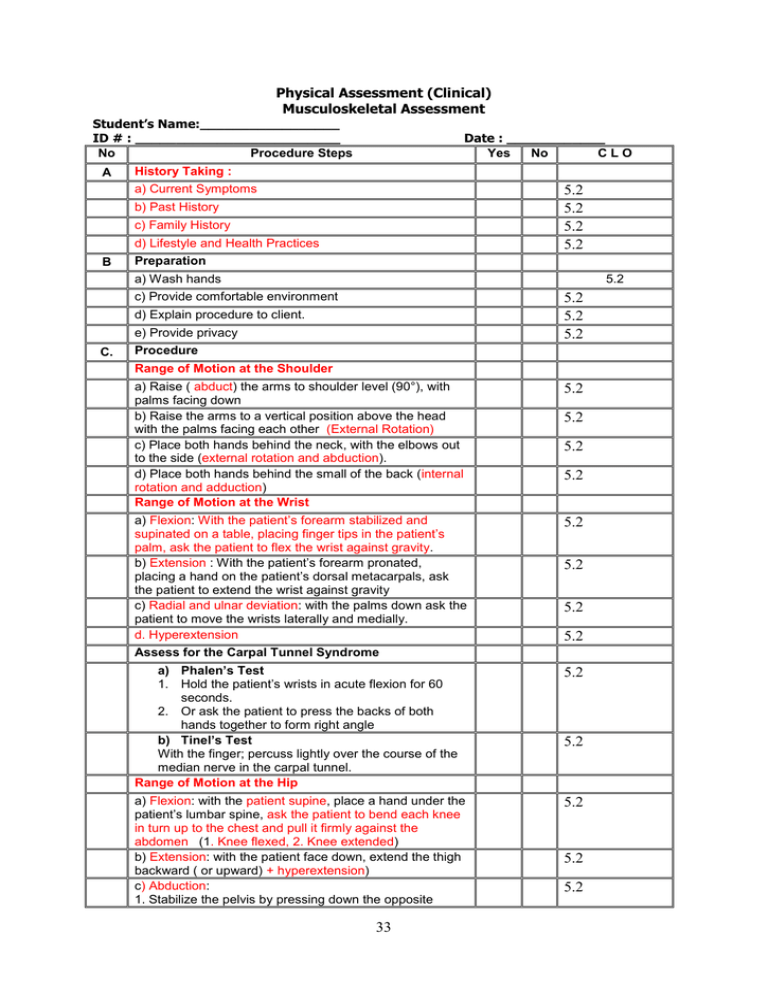
Physical Assessment (Clinical) Musculoskeletal Assessment Student’s Name:_________________ ID # : _________________________ No Procedure Steps A Date : ____________ Yes No CLO History Taking : a) Current Symptoms 5.2 5.2 5.2 5.2 b) Past History c) Family History d) Lifestyle and Health Practices B Preparation a) Wash hands 5.2 c) Provide comfortable environment 5.2 5.2 5.2 d) Explain procedure to client. e) Provide privacy C. Procedure Range of Motion at the Shoulder a) Raise ( abduct) the arms to shoulder level (90°), with palms facing down b) Raise the arms to a vertical position above the head with the palms facing each other (External Rotation) c) Place both hands behind the neck, with the elbows out to the side (external rotation and abduction). d) Place both hands behind the small of the back (internal rotation and adduction) Range of Motion at the Wrist 5.2 a) Flexion: With the patient’s forearm stabilized and supinated on a table, placing finger tips in the patient’s palm, ask the patient to flex the wrist against gravity. b) Extension : With the patient’s forearm pronated, placing a hand on the patient’s dorsal metacarpals, ask the patient to extend the wrist against gravity c) Radial and ulnar deviation: with the palms down ask the patient to move the wrists laterally and medially. d. Hyperextension 5.2 5.2 5.2 5.2 5.2 5.2 5.2 Assess for the Carpal Tunnel Syndrome a) Phalen’s Test 1. Hold the patient’s wrists in acute flexion for 60 seconds. 2. Or ask the patient to press the backs of both hands together to form right angle b) Tinel’s Test With the finger; percuss lightly over the course of the median nerve in the carpal tunnel. Range of Motion at the Hip 5.2 a) Flexion: with the patient supine, place a hand under the patient’s lumbar spine, ask the patient to bend each knee in turn up to the chest and pull it firmly against the abdomen (1. Knee flexed, 2. Knee extended) b) Extension: with the patient face down, extend the thigh backward ( or upward) + hyperextension) c) Abduction: 1. Stabilize the pelvis by pressing down the opposite 5.2 33 5.2 5.2 5.2 anterior superior iliac spine with one hand 2. With the other hand, grasp the ankle and abduct the extended leg until feeling the iliac spine move 3. If there’s limited movement, stand at the foot of the table, grasp both ankles, and spread them maximally, abducting both extended legs at the hips for comparison. 5.2 5.2 12. d) Adduction: With the patient supine stabilize the pelvis, hold one ankle, and move the leg medially across the body and over the opposite extremity. e) Rotation: 1. Flex the leg to (90°) at hip and knee, stabilize the thigh with one hand, grasp the ankle with the other, and swing the lower leg medially for external rotation at the hip. 2. Flex the leg to (90°) at hip and knee, stabilize the thigh with one hand, grasp the ankle with the other, and swing the lower leg laterally for internal rotation. Assessing for Low back pain with radiation to the leg 5.2 13. 1. With the patient supine, raise the patient’s relaxed and straightened leg until pain occurs. 2. Then dorsiflex the foot. Assessing The Knee 5.2 14. a) The Bulge sign ( minor fluids ) 1. With the knee extended, place the left hand above the knee and apply pressure on the supra-patellar pouch, displacing or milking the fluid downward 2. Stroke downward on the medial aspect of the knee and apply pressure to force fluid into the lateral area. 3. Tap the knee just behind the lateral margin of the patella with the right hand. b) The Balloon sign 1. Place the thumb and index of the right hand on each side of the patella 2. With the left hand, compress the supra-patellar pouch against the femur. 3. Feel for fluid entering into the spaces next to the patella under the right thumb and index. c) Balloting the patella ( major effusions ) 1. compress the supra-patellar pouch 2. “ ballotte” or push the patella 3. watch for fluid returning to the supra-patellar pouch. Range of Motion at the Ankle D a) Dorsiflex and plantar flex the foot at the ankle. b) Invert and evert the foot at the ankle. Procedure Termination 16. a) Put client in comfortable position according to health status b) Provide patient with reassurance 17. c) Return back equipments 18. d) Wash hands 15. 34 5.2 5.2 5.2 5.2 5.2 5.2 5.2 5.2 5.2

